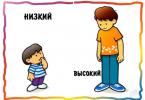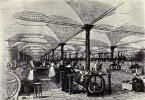Japanese Painting - The popular traditional type of Japanese art, which is divided into many genres and styles.
Japanese-style painting
Nature's motives found the greatest spread in painting in japanese style. Also in the paintings of the rising sun, various scenes were often depicted from everyday life, samurai, mythological heroes.
The most famous genres of Japanese paintings
Japanese painting technique uki
In the 14th century, the style of Uki-Yo, which included engravings on a tree, on which the life of beautiful geish, actors of the Kabuki Theater, Sumo Fighters and various natural landscapes were shown.
In the process of creating Engraving Ukiyo, the artist, a carver and the press and the whole process consisted of several stages participated. Initially, the painter drew a picture on white paper, then the cutter put the glue on the opposite direction and attached it to a wooden board. When the drawing was glued, parts were cut out of it, which were not painted, thus obtained a printed form. Then the black and white prints were made, the painter attached the necessary colors. The carver made the desired number (up to several tens) printed forms that were combined with a given background or color. Printed after discussion with the artist of the color gamut covered the shape of paint and, applying them to a slightly damp rice paper, created a engraving.
The style in which the Japanese engraving was printed was popular not only in Japan, but also among artists of Western countries, such as Vincent Van Gogh, Claude Monet and others. This impact on European art is called "Japan".
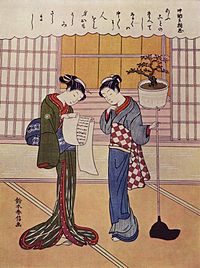
School of Japanese Monochrome Painting Kano
The most famous School of Japanese Fine Art is a Kano school, whose paintings depicted various birds, animals, mythological beings, Cases from the life of ordinary people. The drawings also applied to the sliding doors of Japanese palaces.

Painting Kano.
Artists of the School Kano, to all of the time, are famous for their magnificent monochrome paintings on Sheocha. A distinctive feature of such creations are combinations of real objects and animals that are in the foreground of the image, with abstract, absolutely distracted components of the rear background (for example, clouds).
In modern Japan, there lives a large number of artists who draw in the style of subculture anime and other spheres of the new Japanese culture. Big recognition received Takashi Muroka, working in the studio of Caiika Kiki. He draws pictures dedicated to the life of a post-war Japanese state and anime, in addition, creates sculptures and paintings in surrealistic style and in traditional national genres.
![]()
Japan's painting video
Over the centuries, painting occupied an important place in the culture of the country of the rising sun. About this type of art and will be discussed in the video.
Article genre - Painting of Japan
Japanese painting - one of the most ancient directions in art. Painting in Japan appeared in the most ancient period of the country's history. On pottery and other household items, you can find the simplest images of geometric shapes and various patterns. However, with the arrival of the country chinese cultureThe works of Japanese artists more and more began to contain elements of the painting of the country of Confucius.
One of the most impressive and colorful directions of Japanese painting is the landscape. Japanese artists did not attach a special value of the realistic composition of the composition. The main thing for them was the transfer of impressions from contemplated by them majestations of nature.
How to draw a picture in Japanese style?
Japanese landscape can be depicted by ordinary watercolor paints. To practice, it is necessary to use more water, and more paint add more paint to draw individual parts.
In order to start work, you will need cardboard or watercolor paper, simple pencil, eraser, pastel chalk and, of course, watercolor.

- Start with a pencil sketch. For this picture contours Future picture on a sheet with a simple pencil. Make sure that the lines were very soft and barely noticeable. Press the pencil is needed quite slightly. After all, in the Japanese tradition, the drawing should be very light and almost weightless. In no case do not draw parts with a pencil - this is the concern of a thin brush.
- Portage in the background distant mountains, pagodas, reservoirs, build several traditional Japanese bridges.
- At the outline of the silhouettes of people do not forget to take into account the features of their clothes and posture.
- For paintings in the Japanese spirit already became the usual presence on them the main symbol of this country - blooming sakura. You can also portray this amazing cherry in the beauty with the petals flying in the wind.

- After applying a pencil sketch get painting Pictures. remember, that colors must be weightless, air. To do this, it is necessary to choose the right ratio of water and paint. It is necessary to take into account the ability of cardboard to absorb water, and watercolors to the appearance of flops.
- For dyeing background (for example, sky and water) use thick brushes. Start this process with large parts that are at the top of the picture, gradually descend down until you paint all the water, greens and sky parts in the picture. Then leave the drawing until complete drying.
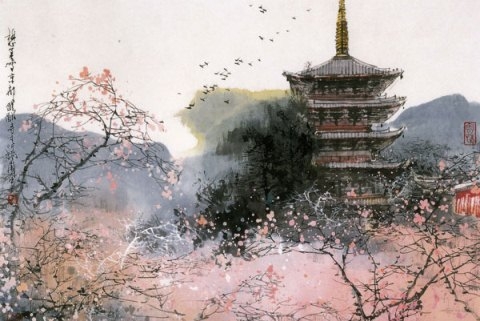
- Now you can go to detail.Take a thin brush and start drawing crowns and trunks of trees, roofs of houses, snowy vertices of mountains. Do not try to draw each item right up to leaves and petals. Your task is to set the direction of buds and branches using several brush strokes. To get the necessary shades, watercolor mix on the palette. It is worth avoiding too obvious, bright shades.
- In one of the corners of the picture lay out japanese hieroglyphs. On the Internet you can find many suitable Japanese poems for you (hockey). These characters do not draw as simple as it seems at first glance, so in their image it is better to practice. To give the letters of a light prescription and some dusting, use black paint, mixed with blue or brown.
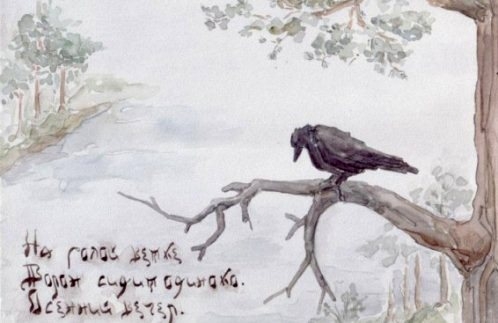
- Using pastel crayons, create shadows. They must be located on the slopes of the mountains and the surface of the water. The main thing is not to overdo it. They should not be too much.
Simple painting in Japanese style
If you do not have a lot of time, and the desire to draw extensive landscapes is not so much, but I would like to decorate the interior of the Japanese "patch", you can use the following method. Draw a thick black paint tree branch. Then in a disposable plate pour a bit of gentle-pink paint. In the paint dip the bottom plastic bottle And make prints on paper. Wait until the drawing is driving. Thus, you will get a wonderful branch of Sakura, without applying your own efforts.
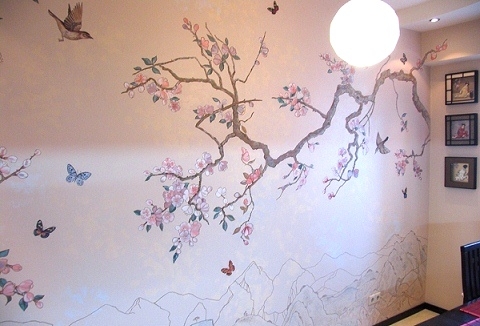
Today, the Japanese topics in the interior is very relevant. These are paintings, and wall decor, and
If you say that the Japanese love their cats, it will not be. Rather, not the whole truth. The Japanese cats love, cherish and admire them. On the Internet a lot of blogs, where the main character is a Japanese cat, the owners of the diaries daily photograph their children and lay out pictures for everyone to review. Such cat diaries have good attendance and a lot of comments. A few words about Japanese cats, in Japan their name is nEKO. (NEKO), and the main breed is Bobtail, its feature is a short tail. All Japanese Naco Blue Blood, if more precisely, they all go beyond to the imperial genus. The fact is that in Japan there are wild cats, but the home does not happen from them, and for the first time arrived at the Emperor Iitzo at the end of the first century, together with the diplomatic mission from China. According to the legend, the monks of the Tendai sect were brought from China to Japan on the ship a lot of Buddhist manuscripts, to protect the precious cargo from mice, they took with them some cats and cats, who were presented as a gift to the emperor. Cats, who settled in the Imperial Palace, were cross each other, which led to mutations and the appearance of short-minded cats such as Bobtail, which in Japan is now a great set. Another legend, the paradise life of the imperial cats ended in 1602, when the production of silk was threatened due to the invasion of mice, destroyed silkworm cocoons. The statues of cats arranged everywhere did not cope with the task of intimidation of mice. Decree of the emperor, all cats were issued to freedom to carry the civil service - the protection of silk and rodents. Unfortunate cats, thrown on the streets of cities, quickly turned out of the palace unblocks in the deft hunters, small thieves and nurses of simpleness. To cause any harm to cats is strictly prohibited, but it was allowed to roaming, and some remained to live where they are satisfied. After some time, the descendants of the imperial cats could be found in the Japanese homes of all classes. Outside of Japan, Bobtail learned relatively recently, after World War II, when the cats were brought to the West American soldiers. The tail of the Japanese bobtail is shortened, there are all verteons in the tail, but they are shortened and deformed. To compensate not enough long tail, the rear paws of the bobtail are much longer than the front. These are very smart cats, they are easy to train, devotees to their owner. Japanese cats are well and harmoniously folded, they are strong, but very slender, elegant and graceful. In the nature of the priest, friendly and affectionate, are perfectly related to children and love to play with them. The Japanese believes that white cats are a symbol of purity, black - scare out unclean power, and the redheads that most are attracting wealth. Three-color cats colors miche (The combination of white-red-black) - bring good luck in everything and are considered a talisman to attract wealth and well-being.
The peaceful types of foggy mountains and scenery of spring valleys, philosophical plots against the background of serene nature and frozen in the rapid motion of the beasts. Is it possible to portray so much with only a few black strokes on white paper? Maybe. Artists of the Ancient East created a style suibokuga or sumi-E..
Suibokuga is translated as "water and ink pattern." Only from the same components and consists of the whole style. Preceding suiboches technicians arose in ancient China. The pictures then were created by simple masses of carcasses. Later, artists began to experiment, trying to achieve combinations of lines to achieve volumes and expressiveness. By the first half of the VIII century, a full-fledged drawing style was born in the era of Dynasty Tan, which we call suybokug today. Word, by the way, Japanese. In the country of the rising sun, the technique became popular in the XIV century. Its adherents were zen monks, aristocrats, rulers and even one very famous swordsman in Japan. His name Miyamoto MusasiBut contemporaries called His Canceray - the Holy Sword.
Musashi is still considered the greatest fencer, as well as an outstanding painter. In his famous treatise, "Book of five rings" he wrote:
"They say that the path of the warrior is a mutual merge of the paths of brushes and a sword, and everyone who strives for comprehend must achieve sufficient heights on both fields"
And after him, many artists compared their craft with fencing. After all, the whole technique is built on a neat, proper brush smear, which can be achieved only in a strict position of the body: the back is straight, the hand is bent in the elbow perpendicular to the body, moves are not done with your fingers, and brush. In such an uncomfortable newcomer, the posture was created and creative masters, giving tribute to tradition.
The Japanese followed the principles of style, which, in fact, was the main alternative to European fine art in ancient times. In China, the tradition of two crops was mixed, the influence of the West began to be traced in the paintings.
The Japanese artists followed the unshakable principles: inexpensive and emptiness, and in understandable language - freedom of space. The masters of this style have always left a certain part of the canvas intact. This fragment of the picture at the completed composition encourages the viewer to fantasize, fill the emptiness with its own images.
The outer simplicity of suibokuga amazes. Once with such a simple technique, the effect of colorfulness, dynamism is created? There are many ways to image individual objects, types of flowers, animals, landscapes. The artists themselves are experimenting with the game of light and shadow, create a variety of shades of white and black. So, for example, snow drifts appear on absolutely white paper.
Today, many are trying to draw colored pastes on sheets with barely noticeable pattern, or at all in the painted. So you can portray flowers more alive. After all, the task of the artist Suibokuga is to pass the instant, the frozen part of reality. Very reminds Japanese lyrics - Haiku. These verses often depict the calegraphs on the canvas.
All over the world are artists who can pass the feelings in the "stopped moment". Archaic Japanese art annually collects a large number of new fans. And it seems that this ancient beautiful formula of emptiness and simplicity will always be correct.
Japan's monochrome painting is one of the unique phenomena of the art of the East. She dedicated to a lot of work and research, but often it is perceived as a very conditional thing, and sometimes even decorative. This is not the so-worthwhile world of the Japanese artist is very rich, and he takes care not so much about the aesthetic component, how much about spiritual. Art historian is the synthesis of external and internal, explicit and implicit.
In this post, I would like to pay attention not to history monochrome painting, and its essence. This will be discussed.
shirma "Pines" Hasegawa Tikhaku, 1593g.
What we see on monochrome paintings is the result of the interaction of the artist Pine Triada: paper, brush, mascara. Therefore, in order to correctly understand the work, you need to understand the artist myself and its attitude.
"Landscape" Sassu, 1398g.
Paper For the Japanese master, not just a girlfriend, which he subordinates his whim, and rather, on the contrary, it is "fellow", therefore, the attitude towards it has developed. Paper is part of the environment, to which the Japanese always treated tremble and tried not to subordinate to themselves, but peacefully coexist with her. Paper is a tree that stood in a certain area, a certain time, "saw" something around him, and she keeps it all. So the material perceives the Japanese artist. Often the masters before starting the job, they looked at the clean sheet for a long time (contemplated it) and only then kiwood began. Even now modern Japanese artists who are engaged in Nihon-Ga (traditional Japanese painting) carefully choose paper. They buy it under the order on paper factories. For each artist of a certain thickness, moisture permeability and invoices (many artists even conclude an agreement with the owner of the factory not to sell this paper to other artists) - therefore, each picture is perceived as something unique and alive.
"Reading in the bamboo grove" Subun, 1446g.
Speaking of the significance of this material, it is worth mentioning such well-known monuments of the literature of Japan as "notes from the head of Sayny Syunagon and" Genji Monochtari "Murassaki Sikibu: both in the" notes ", and in the" Genzi "you can meet plots when court or lovers exchange messages . The paper on which these messages were written was the corresponding time of the year, the shade, and the manner of writing the text corresponded to its texture.
"Marassaki Sikibu in the temple of Iciim" Kesen
Brush - The second component, this is the continuation of the hand of the master (again - this is natural material). Therefore, the brushes were also made to order, but most often the artist himself. He selected the hairs of the required length, chose the size of the brush and the most convenient handle. The master writes only his brush and no other. (From personal experience: was on the master class of the Chinese artist Jiang Shilun, the audience asked to show that his students who were present at the master class, and each of them, taking a brush of the master, said that it would not be what they would expect Since the brush is not them, they are not accustomed to her and do not know how to use it).
Fuji Sketch Katsusik Hokusai
Mascara - the third important element. Mascara happens different species: It can give a glossy or matte effect after drying, maybe with an admixture of silver or oath shades, so right choice Masca is also not small.
Yamamoto Baitz, end of the XVIII - XIX century.
The main plots of monochrome painting are landscapes. Why is there no color in them?
Steam shirma "Pines", Hasegawa Tikhaku
First, the Japanese artist is not interested in the subject itself, and its essence, a certain component, which is common to all living things and leads to human harmony. Therefore, the image is always a hint, it is addressed to our feelings, and not to sight. In obviousness is the incentive of dialogue, which means the compounds. In the image, lines and stains are important - they form the artistic language. This is not a master's liberty, which where wanted, left a fat footprint there, and elsewhere, on the contrary, was undersonated - everything has its meaning and meaning, and does not carry a random nature.
Secondly, the color always carries some emotional color and perceived differently different people in different states, Therefore, emotional neutrality allows the viewer to join the dialogue most adequately, to arrange it to perception, contemplation, thoughts.
Thirdly, this is the interaction of Yin and Yang, any monochrome picture is harmonious in terms of the ratio of carcass and untouched paper area.
Why most of the paper space is not involved?
"Landscape" Subun, middle of the XV century.
First, the openness of the space is dipping a visitor to the image; Secondly, the image is created as if it fell on the surface for a moment and is about to disappear - this is due to the worldview and worldview; Thirdly, on those areas where there is no carcass to the fore. The texture and shade of paper (on the reproductions it is not always visible, but in fact it is always the interaction of two materials - paper and carcass).
SESSU, 1446
Why landscape?
"Contemplation of waterfall" Gayami, 1478g.
According to the Japanese worldview, the nature of the person is perfect, so he must learn from her, in every way to protect it, and not destroy or subordinate. Therefore, many landscapes can see small images of people, but they are always insignificant, small in relation to the scenery itself, or images of huts that are inscribed in their space and are not always noticeable - these are all symbols of the worldview.

